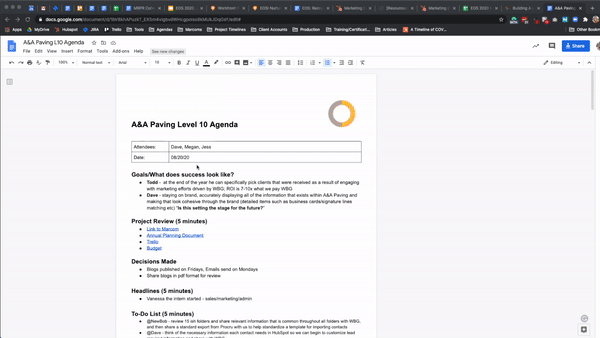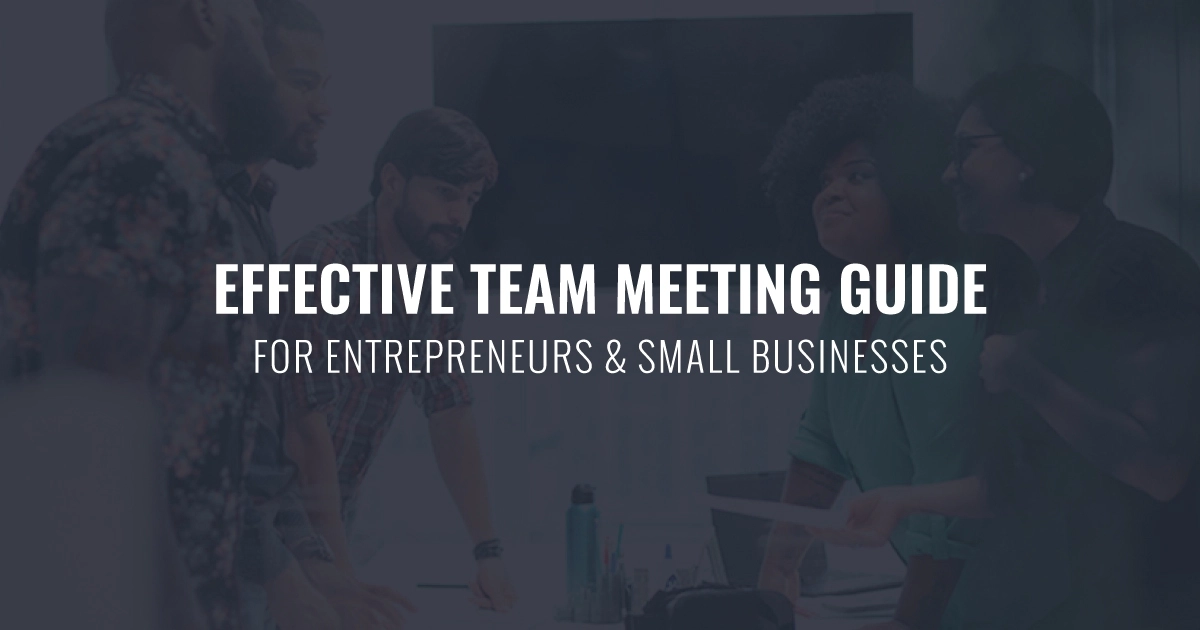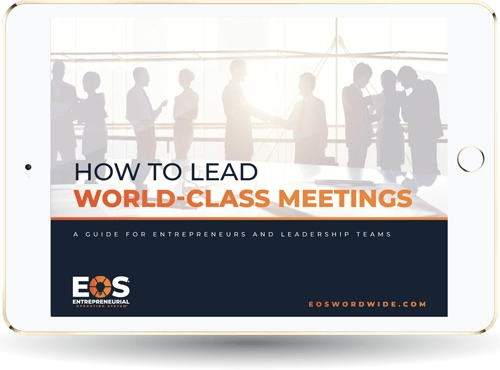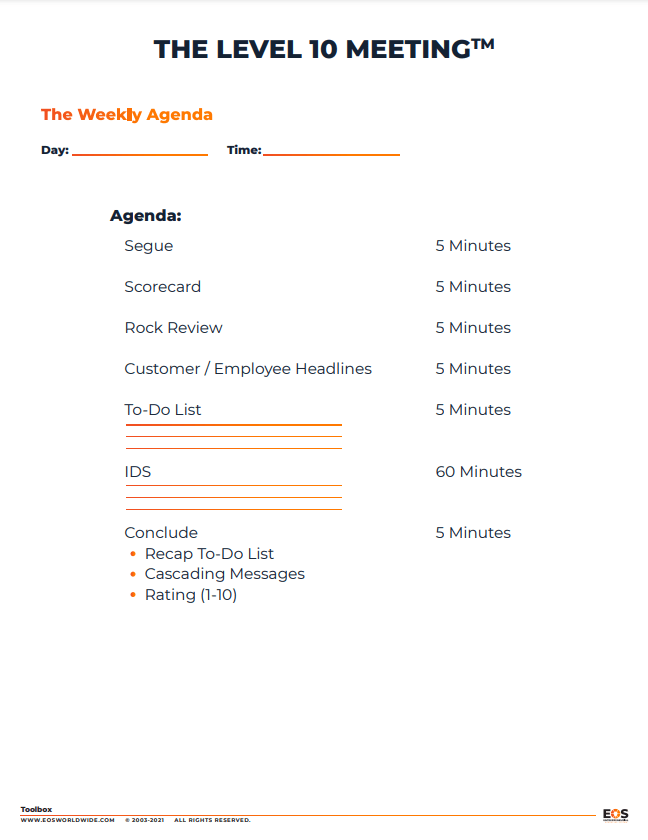Effective Team Meeting Guide for Entrepreneurs and Small Businesses
What you'll Learn
- Signs of a bad meeting and what that will cost you
- Actionable tips and tools for your next meeting
- Insights from world-class business coaches
- Success stories from entrepreneurial companies
- EOS® terminology that you should know
Who this Guide is For
- Entrepreneurs and their leadership teams
- Companies that want to grow
- Anyone who has ever suffered in a meeting
Click on any chapter to scroll directly to it
TABLE OF CONTENTS
Chapter 1
Suffering From Meeting Fatigue
Being an entrepreneur and running your own business is both challenging and exciting. Most entrepreneurs, or visionaries as we call them at EOS, are focused on the big ideas and creative problem solving needed to keep their businesses thriving. However, it’s the day-in-day-out things like regular meetings that help turn those visions into action.
But here’s the problem. If you surf the internet, you’ll find t-shirts, mugs, and mouse pads emblazoned with phrases like:
“I survived another meeting that could have been an email."
"Wake me when the meeting is over!"
Or the mother of them all…

Why are team meetings so universally hated? It’s because many meetings are a huge waste of time. The thing is, entrepreneurial businesses need regular, effective team meetings in order to stay healthy, get Traction®, and grow.
At EOS, we’ve helped thousands of entrepreneurial businesses around the world solve this very problem. As a matter of fact, our clients actually love their meetings thanks to our simple solution.
Are we suggesting that we have a cure for bad meetings? Yes, we are.
But first, let’s talk about the elephant in the room…
Chapter 2
The Business Meeting: Hated By Many, Mastered By Few
Why do we need this guide?
As we said, most meetings are a waste of time. Add to that the painful practices of many meetings and it’s no wonder people avoid them.
In fact, back in 2015 Inc. Magazine wrote about some alarming trends in modern business meetings that didn’t bode well for any of us:
- There was an increase in weekend meetings (oh no they DIDN’T!)
- 81% of all meetings started late (no surprise there)
- Most happened at the worst time of day (the dreaded 3 p.m. slot)
To make things even worse, we’re also meeting more frequently than we did in years past thanks to trendsetting, meeting-happy companies like Google and Apple.
Many times, the people who need to be in the meeting rarely are and even if they are, it’s just as rare that the meeting is running off a clear agenda.
Alas, these were the problems of a simpler time.
Enter: The Global Pandemic.
By far, the most effective meeting rhythm I've seen...it keeps our Chosen Care, Inc. team on track with accountability and we consistently solve issues. No more death by meetings and we routinely hit close to 10!

Effective team meetings just got a whole lot more complicated thanks to an increase in working-from-home and reliance on conferencing software that many folks are still getting used to. And if you thought keeping people focused face-to-face was hard, try it when there’s a toddler wailing in the background of a video call (“Please mute yourself, Cathy. And does your dog really need to be in this meeting?”).
With the average employee sitting in 62 meetings a month, 31 hours of which they consider unproductive, it’s critical to understand what we’re doing wrong so we can do better.
So what’s an entrepreneur to do?
Chapter 3
When Meetings Attack: The 5 Offenders
At EOS, part of our mission is to help identify the big issues that are holding our clients’ businesses back – one of them often being unproductive meetings.
After speaking to hundreds of business owners in entrepreneurial companies, we’ve narrowed the big meetings issues down to these top five offenders:
1. Lack Of Time Integrity
As we mentioned earlier, most meetings don’t begin on time and therefore, don’t end on time. This is extremely disrespectful to anyone attending the meeting, especially if they have another meeting directly afterward. This sets off a cascading effect that ruins their day. And it’s bad for your reputation! If your meetings never start on time, people will perpetually show up late.
2. Device Distractions
Have you ever been in a meeting where everyone’s faces were buried behind screens? Devices equal distraction. As a matter of fact, 70% of employees in a recent Atlassian survey said they’re doing other work during meetings. No wonder Dave from accounting gave you that blank stare when you asked if he was “on board for big changes” (Dave was searching for tee times on his phone). And speaking of being on board…
3. Mandatory Fun
Most business team meetings are mandatory. Whether it’s a conference room or Zoom room, people often feel trapped. This means there’s no buy-in to the point or purpose of the meeting and ultimately, there’s no motivation toward positive outcomes.

4. Rabbit Holes
Ah, the rabbit hole. It goes like this: Carol asks how we’re doing on fundraising for the golf event (this is probably when Dave got distracted). Jack then asks if we’re getting golf towels printed with the logo on it. Mia pipes up about how much she hates the logo and how we need to talk to marketing about re-branding the company. This sets off several people who love the logo the way it is. Now we’re arguing about a logo. Thanks, Jack.
I used it at my last company with wild success. Now I use it at my new company, my home life, and help others implement EOS. What a GREAT tool to stay on track.
5. Unproductive Meetings
This is perhaps the biggest reason people avoid team meetings altogether. They seem pointless. That’s because in many cases, they are. Did we really just argue for half an hour about a logo when we’re under the gun to get the money raised for the charity golf event? Yup. And now, your participants are a lot less likely to show up to your next meeting on-time, on-board, and focused.
Wash. Rinse. Repeat.
Chapter 4
4 Ways Bad Meetings Hurt Business
Bad team meetings aren’t just painful for participants – they can hurt your business too.
Here are four negative side effects of bad team meetings:
1. They’re Expensive
From the office space to the human capital to the wasted time, meetings cost money.
A 2019 Korn Ferry survey found:

of respondents say that spending too much time in meetings and on calls distracts them from making an impact at work.

say they waste between 2-5 hours per week on calls or meetings that don’t accomplish anything.
2. People Lose Interest
When people lose interest in attending your meetings, it means you can’t solve your issues and move forward.
3. Bad for Team Dynamics
Bad meetings can cause bad behavior. Collective frustration can lead to employees throwing each other under the bus and avoiding each other.
4. Your Issues Go Unsolved
When you’re stuck in bad meetings your business will remain stuck in place as well.
Now that we use the L10 Meeting Agenda our team has clarity! We’re always on the same page, know exactly where we’re at towards hitting our goals, and can solve our problems and move efficiently. Our L10’s are our Lifeblood!
Chapter 5
4 Signs of an effective team meeting
We’ve talked about the bad – now let’s look at the good!
Here are 4 signs of an effective team meeting:
1. Clear Expectations
You’re setting clear expectations for what will happen in the meeting to keep everyone focused on the tasks at hand.
2. Issues Are Getting Solved
You’re walking out of your meetings with 90% of your issues solved. Anything that doesn’t get solved because of time or other factors is tackled in the next meeting.
3. You Begin And End On Time
Your meetings should always begin and end on time – no matter what!
4. Engagement is High
You banned devices and got everyone – even your introverts – to participate.
Chapter 6
The Level 10 Meeting
Here at EOS, not only do we know how to improve meetings, we have a secret weapon you can use to make your meetings worthwhile and simply amazing:
The Level 10 Meeting
The Level 10 Meeting is a 90 minute meeting that begins and ends on time, has high engagement, holds everyone accountable, and ends with multiple issues solved – for good! It follows what we call the Level 10 Meeting Agenda and it has a repeatable flow that helps keep the whole thing on track. The heart and soul of a Level 10 meeting is the issue-solving or “IDS®” portion. It’s the most satisfying part for attendees because it prioritizes and solves the most pressing issues that are holding you back from progress -more on this below!
Fun Fact: The Level 10 Meeting gets its name from the after-meeting ritual when attendees rate the meeting’s effectiveness from 1-10, 10 being the most productive. You should be striving for a 10 from everyone, every time!
Here’s our founder, Gino Wickman, with more on that:
The Flow of a Level 10 Meeting
Start On Time
This is imperative!
Share Good News
We call this the “Segue.” This is a rapid-fire, simple sharing of personal and professional good news around the table. It helps the leadership team transition from working IN the business to working ON the business. It also helps humanize the meeting.
Reporting Mode
This is your time to make sure that everything is on track – your numbers, your people, and your priorities. This includes reviewing your Scorecard for five minutes and then reviewing your Rocks for five minutes. Then share customer and employee headlines – both good and bad news. Any number, Rock, or customer or employee headline that needs discussion gets dropped down to the Issues List for solving.
One of the most incredible benefits of the Reporting section is the fact that you can get a REAL pulse on your entire business in just 20 SHORT MINUTES --including all the trends and priority updates in a rapid, organized order. It's pretty remarkable in its simplicity.

Pam Kosanke
Marketing Leader, EOS Worldwide
Pro Tip: Do NOT try to solve issues during reporting time. You’ll get to do that next. Squirrels are tempting to chase – but they can lead you down the dreaded rabbit hole!
Develop The To-Do List
Throughout the Level 10 Meeting, you’ll be creating a to-do list to help get things done and hold everyone accountable. To-dos should be solvable within 7 days (if it’s a larger effort it could be a Rock!). 90% of your to-dos should be done by the next meeting.

Issue Solving Portion:
We mentioned this above because it’s the big one. The most important part of your Level 10 Meeting.
IDS stands for Identify, Discuss, and Solve. This is where the real magic happens! This is your time to “IDS” the issues you identified during the Reporting section of the meeting.
Here’s how to IDS like a Pro:
Prioritize your issues with 1, 2, and 3 from the most important to least important issue to solve that day. Once you’ve identified the most important issues, you then discuss the issue until you solve it. Once an issue is solved, remove it from the Issues List and create a corresponding to-do. Keep working on the rest of your list the same way until all issues are solved.
Each time you revisit the Issues List in a new Level 10 Meeting, you should re-prioritize the top 3 issues. Focus on solving them first. If something is no longer an issue you can remove it from the list. If no one can remember what it was about (it happens!) then remove it from the Issues List as well.
Keep in mind that in order for your Level 10 Meeting to be successful you'll need to be disciplined about prioritization of issues. Focus on solve the three most critical issues FIRST.

Mark O'Donnell
Visionary, EOS Worldwide

Pro Tip: You’ll need to dedicate 60 minutes to the IDS portion of your meeting, so make sure the other sections are tightly monitored for time! This is the whole reason why we meet – to solve issues. This time is sacred.
Conclusion:
In the last 5 minutes of your meeting you will recap the To-Do list, discuss any cascading messages that need to go out to the rest of the organization, then rate the meeting. Ask each person to score the meeting from 1-10, with 10 being a perfect meeting.
8 is the minimum standard score in a Level 10 Meeting. If you get lower than an 8 you need to ask the person why and discuss quickly.
Follow the Level 10 Meeting Agenda outlined here for your next meeting
A lot of our meetings were unproductive. Either we planned well without follow-through, or we circled around issues without addressing the root. EOS helped on both fronts, giving us structure for accountable action and helping us cut to the heart of key issues
Chapter 7
Pro Tips From Our Business Coaches
Effective team meetings don’t happen by accident – they happen with careful planning by following these best practices from our experts:
Get More from your Team Meetings with a Powerful Pulse
Inserting timely, powerful pauses in your EOS Level 10 Meetings will allow everyone time to recall the week’s activities and to share every Issue and every Customer and Employee Headline so that your leadership team can work to clarify and resolve those issues.
Improve engagement by practicing what we at EOS call open & honest communication. While it can feel dangerous at times, it allows everyone in the room to be heard and helps you get to the root of your issues.
5 Simple Keys to Ending Painful Company Meetings
It’s possible to lead world-class company meetings. The solution is baked into the EOS Level 10 Meeting Agenda, and five simple rules for running effective team meetings.
8 Tips to propel your meetings to the next level
Want to take your leadership team meetings from effective and tolerated to powerful and enjoyable? Here are eight tips to improve your company meetings.
5 Ways to Boost Employee Engagement in Meetings
If you’re having a hard time getting employees engaged in meetings, you’re not alone. Here are 5 tips for increasing participation in EOS Level 10 meetings.
Download the Level 10 Meeting™ Agenda
Chapter 8
Level 10 Meetings: A LOVE STORY
We asked companies currently running on EOS about their experiences with the Level 10 Meeting.
Level 10 Meetings Drove Positive Change In Our Organization
Federated Service Solutions, Farmington Hills, MI
Laura Elgood, Vice President & Integrator
We started running our business on EOS in January of 2017 because we had hit a breaking point. Most notably, accountability and communication were not working well at all, causing constant fires and frustration at all levels of the organization. Our business was being run reactively not proactively and everyone was rowing in different directions!
After we began implementing EOS and defining departments and roles more clearly and documenting our vision, we got clarity. We rolled out Level 10 Meetings slowly through our organization with the help of our awesome EOS Implementor and this is when we really started seeing change. Our meetings were enabling our employees to solve their own problems!
Four years later we are still learning and growing, hitting our goals, managing proactively, and solving the real issues in our business.
Employees continue to tell us that the Level 10 Meetings are one of the major things working in the organization because they’ve changed the way we attack issues and pulled us from what we always felt was the hamster wheel phenomenon. No more running in circles and going nowhere!
Level 10 Meetings Provided The Structure We Needed
Hivehouse Digital, Ann Arbor, MI
Chris Beecher, President
Back before we started using EOS and the weekly Level 10 Meeting process, our meeting times and dates were fairly random. We could never seem to start on time and even more aggravating, we never ever ended on time. We lacked time integrity and structure and often found ourselves reporting out on tasks, griping about what was going wrong, and never getting to our root issues – and certainly never solving them. Our meetings were a disaster.
The EOS Level 10 Meeting Agenda gave us the needed structure and rules of engagement. Everyone on the team now understood that these meetings were weekly, on the same day, beginning at the same time, and ending at the same time.
More importantly, our team could discuss and SOLVE issues that were holding us back. With the framework of the Level 10 Meeting in place, we had the consistency and space where our team could feel safe to air out issues, receive feedback, and eventually as a team, solve the issue.
Level 10 Meetings Helped Everyone Participate
MRPR, Southfield, Michigan
Greg Zink, Principal & CPA
Our firm, MRPR CPAs and Advisors, has been running on EOS for three years. It was introduced to us about a year after we had gone through a merger and leadership changes.
The EOS process enabled us to come together and agree on our core focus and values. We there then able to come up with our company vision 1, 3, and 10 years out. This was a surprise to me in that it was achievable and not a corny process.
Although EOS brings many tools to handle people problems, the tool that I like the most is IDS. IDS is identify, discuss, solve. “Let’s IDS it” as we say. It’s a simple process that lets everyone in the room participate and ultimately solve any problem at hand in the best interest of the firm.
Chapter 9
Best Practices for Virtual Meetings
10 tips for Greatly Increasing The Productivity of your virtual meetings
Having an organized structure for your meeting is vital in our virtual world. With work from home being so prominent, meetings are being held via video-sharing services like Zoom and Microsoft Teams. EOS One is the official software for running a virtual Level 10 Meeting™. Easily add issues, check in on Rocks, an Identify, Discuss, and Solve (IDS™). Each segment, from the segue to the conclusion, is timed, helping you stay on track for 90 minutes.
Chapter 10
Free Tools for More Effective Team Meetings
Check out these free tools right now from the EOS Toolbox™:
Or, subscribe to our blog and YouTube channel.
Stop Bad Meetings Today
It’s rare that there’s a simple solution to an age-old problem, but in this case, it’s true. By using the Level 10 Meeting Agenda and adhering to the meeting best practices we’ve outlined here, you can stop bad meetings today. More importantly, by conducting better meetings, you will get to the root causes of the issues that are holding you back, you will assign champions to solve these issues, you’ll save money – and you’ll see big changes in your business in just a few weeks.
One more thing: it never hurts to have snacks in your meetings.
Need help getting your organization healthy and poised for growth?
Need help getting your organization healthy and poised for growth? Get in touch with us today to get started with EOS.
Or…get a quick pulse on your organization’s health right now by taking our Organizational Checkup® – for free!
EOS Glossary
Terms to Help you Navigate EOS
EOS is a language onto itself. Here are a few EOS terms from our glossary that will help you navigate the Entrepreneurial Operating System for the first time – or at least help clarify a term that you’ve heard before but are unclear about:
Entrepreneurial Operating System® (EOS®): A proven set of simple, practical tools that improves how people in an organization meet, solve problems, plan, prioritize, follow processes, communicate, measure, structure, clarify roles, lead, and manage.
The EOS Model®: Every business is comprised of Six Key Components™ as depicted by the EOS Model. Those six components are: Vision, People, Data, Issues, Process, Traction®. These must be managed and strengthened to create a healthy, well-run business.
Vision Component: Getting everyone in the organization 100% on the same page with where your company is going and how you’re going to get there.
People Component: Getting the right people in the right seats.
Data Component: Using a handful of numbers that give everyone an exact pulse on where things are and when they are off track.
Issues Component: Strengthening your organization’s ability to identify issues, discuss them, solve them, and make them go away forever.
Process Component: “Systemizing” your business by identifying and documenting the core processes that define the way to run your business.
Traction Component: Bringing discipline and accountability into the organization.
Integrator: The leader of a company’s leadership team. Integrators beat the drum, break the ties, harmoniously integrate other major functions in the organization, and accept ultimate accountability for achieving results.
Scorecard: An EOS Tool used to track a handful of numbers that give you a pulse on your business.
Accountability Chart™: Different from an organizational chart, an Accountability Chart defines the right structure for your company and clearly identifies who is accountable for what.
Rocks: The 3 to 7 most important things you must get done in the next 90 days. Employees will typically have 1-3 individual Rocks each quarter while leadership team members will typically have 3-7 individual Rocks.
Measurables: When companies use EOS, everyone “has a number” that is considered their measurable – something they do to contribute value to the organization that is measured on a consistent basis.
V/TO™ (Vision/Traction Organizer™): A two-page document that helps your leadership team define, document, agree on, and share the company vision.
10-Year Target™: A long-range, energizing goal for the organization, ranging from five years to twenty years out.
Core Focus: Your core focus defines what you are as a company to help you avoid “shiny stuff” and keep you focused on the areas where your business excels. It comes from the intersection of knowing “Why” your company exists and “What” you do in the world.
Core Values: A timeless set of guiding principles that define your culture and the behaviors you expect from each other. They help you determine who fits your culture and who doesn’t and they help you attract like-minded people to your team.
Marketing Strategy: The definition of your ideal customer and the most appealing message to attract them to your business. It should provide a laser-like focus for your sales and marketing efforts.
3-Year Picture™: A definition of what your company will look like, feel like, and be like in three years. The 3-Year Picture creates a powerful image of the future and helps everyone work towards the same vision.
1-Year Plan: Defines your objectives for the year by identifying and crystallizing your revenue target, profit target, and measurables, along with your top three to seven goals for the year.
SMART: Stands for Specific, Measurable, Attainable, Realistic, and Timely. Making goals and Rocks SMART is essential for creating crystal clear communication and for setting the right expectations between you and your team so everyone knows what “done” looks like.
IDS™: Also known as the Issues Solving Track™, IDS is the process your team uses to identify, discuss, and solve issues on an ongoing basis.
Level 10 Meetings™: A weekly meeting with a specific agenda designed to help you stay focused on what’s important, solve issues effectively, and keep your team connected.
People Analyzer™: A simple tool that pulls your core values and Accountability Chart together to help your organization identify if they have the right people in the right seats.
Visionary: Often the company founder, a visionary is a strategic thinker who always sees the big picture and is tuned into the future of your industry. Visionaries are usually great with big relationships and the culture of the organization.
Organizational Checkup®: A 20-question survey that helps measure a company’s strength in the Six Key Components.











